History
Construction was started on the C. H. Moore Homestead by John and Minerva Moore Bishop. Mr. Bishop was a prosperous grain and lumber dealer in Clinton. Work on the C. H. Moore Homestead was completed after the Civil War had ended and life took on a more normal pattern. Soon after this, the Bishops lost their only child. After Minerva Bishop's death in the early 1880s, Mr. Bishop sold the house to his brother-in-law, Clifton H. Moore. [2]
Moore, an educated man, was the first resident attorney to commence practice in Clinton, having hung out his shingle in 1841. He served as co-counsel with Abraham Lincoln on several cases heard in the DeWitt County circuit court, of which future United States Supreme Court justice David Davis was the presiding judge. [2]
The west wing of the home was added in 1887 to house Mr. Moore's vast collection of books. At the time of his death, he owned approximately 7,000 volumes, the largest collection of books in downstate Illinois. [2] The two-story high library has a vaulted ceiling and stenciled walls. There are four-season windows on the upper level, and an iron railing around the suspended upper gallery. The furniture and paintings include many of the original Moore furnishings. Moore's book collection was left to the city of Clinton upon his death and is now housed at the Vespasian Warner Public Library.
Moore lived in the house until his death in 1901. The house sat in disrepair for several decades until 1967 when it was purchased and restored by the newly formed DeWitt County Museum Association. The Apple 'N Pork festival, held annually the last full weekend in September and established by the DeWitt County Museum Association, was first held in 1967 to help raise funds to restore and maintain the mansion.

Clinton is the largest city in DeWitt County, Illinois, United States. The population was 7,004 at the 2020 census. It is the county seat of DeWitt County.
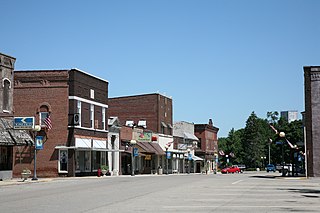
Farmer City is a city in DeWitt County, Illinois, United States. The population was 1,828 at the 2020 census.
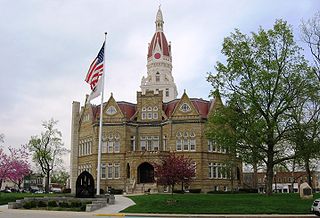
Pittsfield is a city in and the county seat of Pike County, Illinois, United States. The population was 4,576 at the 2010 census, an increase from 4,211 in 2000.

Historic Rock Ford, which is also known as the General Edward Hand House, is an historic house in southeastern Lancaster, Pennsylvania. Although the property is surrounded by Lancaster County Central Park, it is privately owned and operated by the Rock Ford Foundation, a 501(c)(3) not-for-profit organization.
The Illinois Historic Preservation Division, formerly Illinois Historic Preservation Agency, is a governmental agency of the U.S. state of Illinois, and is a division of the Illinois Department of Natural Resources. It is tasked with the duty of maintaining State-owned historic sites, and maximizing their educational and recreational value to visitors or on-line users. In addition, it manages the process for applications within the state for additions to the National Register of Historic Places.

West Overton is located approximately 40 miles (64 km) southeast of Pittsburgh, in East Huntingdon Township, Westmoreland County, Pennsylvania, United States. It is on PA 819 between the towns of Mount Pleasant and Scottdale. Its latitude is 40.117N and its longitude is -79.564W.
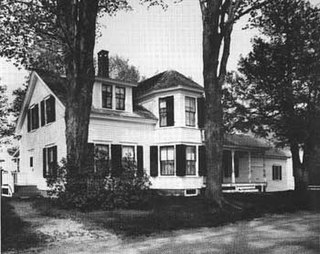
The Coolidge Homestead, also known as Calvin Coolidge Homestead District or President Calvin Coolidge State Historic Site, was the childhood home of the 30th president of the United States, Calvin Coolidge and the place where he first took the presidential oath of office. Located in Plymouth Notch, Vermont, Coolidge lived there from age four in 1876 to 1887, when he departed for Black River Academy for education. He is buried in Plymouth Notch Cemetery not far from the home.

The David Davis Mansion, also known as Clover Lawn, is a Gilded Age home in Bloomington, Illinois that was the residence of David Davis, Supreme Court justice (1862–1877) and Senator from Illinois. The mansion has been a state museum since 1960. It was added to the National Register of Historic Places in 1972 and was designated a National Historic Landmark in 1975. In celebration of the 2018 Illinois Bicentennial, David Davis Mansion was selected as one of the Illinois 200 Great Places by the American Institute of Architects Illinois component.

The Joseph F. Glidden House is located in the United States in the DeKalb County, Illinois city of DeKalb. It was the home to the famed inventor of barbed wire Joseph Glidden. The barn, still located on the property near several commercial buildings, is said to be where Glidden perfected his improved version of barbed wire which would eventually transform him into a successful entrepreneur. The Glidden House was added to the National Register of Historic Places in 1973. The home was designed by another barbed wire patent holder in DeKalb, Jacob Haish.

The Magill House is a historic hotel located at 100 N. Center St. in Clinton, Illinois. Construction on the building began in 1872 and was completed in 1873. The hotel was built in order to entice the Illinois Central Railroad to move the headquarters of its Springfield Division to Clinton; the effort was successful, as the railroad moved to Clinton in the late 1870s. From its construction through the mid-20th century, the hotel was considered the finest in Clinton, and housed both Illinois Central employees and travelers on the railroad. The hotel transitioned to an apartment hotel in the 1970s, and after the late 1980s it declined and ultimately closed.

Hill–Stead Museum is a Colonial Revival house and art museum set on a large estate at 35 Mountain Road in Farmington, Connecticut. It is best known for its French Impressionist masterpieces, architecture, and stately grounds. The property was designated a National Historic Landmark as a nationally significant example of Colonial Revival architecture, built in 1901 to designs that were the result of a unique collaboration between Theodate Pope Riddle, one of the United States' first female architects, and the renowned firm of McKim, Mead & White. The house was built for Riddle's father, Alfred Atmore Pope, and the art collection it houses was collected by Pope and Riddle.

The Dewitt Log Homestead is a historic building near Oxford, Ohio, listed in the National Register on 1973-04-13.

The John H. Addams Homestead, also known as the Jane Addams Birthplace, is located in the Stephenson County village of Cedarville, Illinois, United States. The homestead property, a 5.5-acre (22,000 m2) site, includes an 1840s era Federal style house, a Pennsylvania-style barn, and the remains of John H. Addams' mill complex. The house was built in two portions, in 1846 and 1854 by Addams; he added some minor additions during the 1870s. Other major alterations took place during a 1950s modernization of the home. The homestead has been noted for its significance to industry and politics. On September 6, 1860, future Nobel Peace Prize recipient Jane Addams was born in the house.
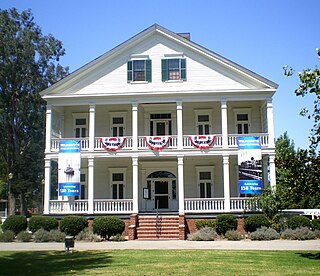
Banning House, also known as the General Phineas Banning Residence Museum, is a historic Greek Revival-Victorian home in the Wilmington section of Los Angeles, California. Built in 1863 by Phineas Banning near the original San Pedro Bay, it remained in the Banning family until 1925 and has been owned by the City of Los Angeles since 1927. The home, barn and gardens are now operated as a museum. The Banning House property, also known as Banning Park, has been designated as a city Los Angeles Historic-Cultural Monument and state California Historical Landmark and has been federally listed on the National Register of Historic Places.

The Cherry Hill Farmhouse is a house museum in Falls Church, Virginia, United States. Built in 1845 in a Greek Revival architecture style, it belonged to wealthy farmer families until 1945, and in 1956 it became property of the City of Falls Church, which transformed it into a museum, as a historical building. Today, the Cherry Hill Farmhouse, along with other five such constructions in Falls Church City, is part of the National Register of Historic Places, as an important testimony of 19th century Victorian buildings in the area.

Sahuaro Ranch was founded in 1886, by William Henry Bartlett, a native of Illinois. The ranch, located north of what eventually became the city of Glendale, Arizona, was rich in figs and other fruit orchards, vineyards, and fields of alfalfa. The ranch has all of its historical structures restored, and the "Sahuaro Ranch Park" is administered by the Parks and Recreation Department of Glendale.

Manistee Ranch was founded in 1897 by Herbert W. Hamilton, a native of Wisconsin. The ranch, located in the town of Glendale, Arizona, was rich in citrus fruits and dates. The ranch has all of its historical structures restored. It is administered by the Parks and Recreation Department of Glendale.

The Clover Bottom Mansion is a historic mansion located in Nashville, Tennessee, United States. It is the home of the Tennessee Historical Commission, the State Historic Preservation Office.
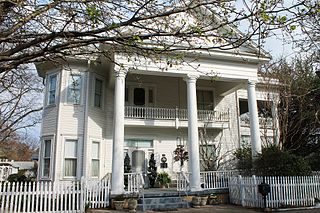
The Marcus DeWitt Carlock House is a house with Neoclassical and late-Victorian architectural characteristics that is listed on the National Register of Historic Places and as a Recorded Texas Historic Landmark located at 407 South Main Street, approximately three blocks south of downtown, in Winnsboro, Wood County, Texas. It was the first National Register of Historic Places listing in the city of Winnsboro.

Newland House is an 1898 farmhouse in a midwestern adaptation of a Queen Anne architectural style in Huntington Beach, California, listed on the National Register of Historic Places. It is one of 123 historic places and districts on the National Register of Historic Places in Orange County, California. The Newland House is listed as the ninth historic place to receive a historical plaque from the Orange County Historical Commission in cooperation with the Orange County Board of Supervisors. The house has been identified as the site of the Tongva village of Lupukngna.




















